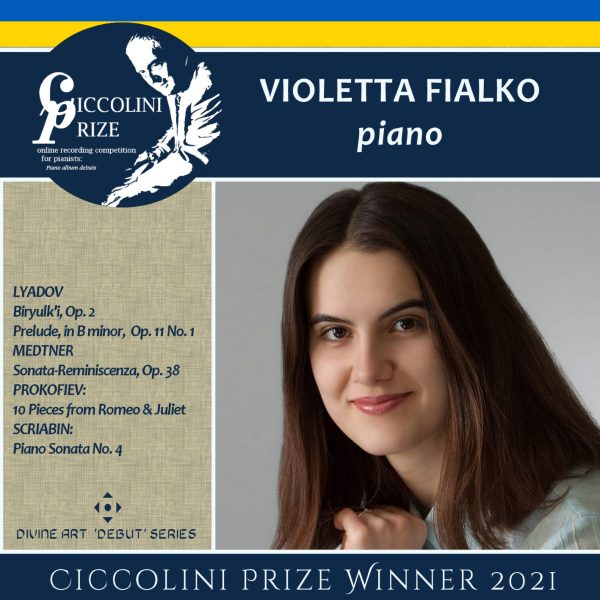Textura
As its title indicates, Violetta Fialko’s commercial recording debut directly resulted from her winning the 2021 Ciccolini Prize for Pianists, a new international competition that attracted entrants from many countries. Among the prizes the Ukrainian virtuoso received for winning the competition was a recording with Divine Art, hence the recital album. Born in 1997, Fialko has won multiple awards and since 2018 has worked as an accompanist at the Lysenko Kyiv Specialized Music Scholl and as a teacher of piano performance and music theory at the Ukrainian Evangelical Theological Seminary and at the Music Art Academy. Her circumstances, however, have changed since the war in Ukraine erupted and she was evacuated from her home town to a safe house. While her seventy-minute release focuses on Russian Romantic classics, Prokofiev was, in fact, born in Ukraine. Nothing in the album content explicitly addresses war, though its very existence might be seen as a symbol of support for Fialko’s country and for peace and freedom in general.
The collection commences with the fourteen miniatures of Biryul’ki (1876), one of two Lyadov pieces performed and the composer’s first work for piano. If a spirit of child-like playfulness colours the material, it’s intentional: in playing biryul’ki, one plays with small toys that are hooked back one by one without one touching the rest. All fourteen settings are executed with authority by the pianist, who never lets their considerable technical challenges dampen their carefree spirit. Complementing Biryul’ki is Lyadov’s also-compact Prelude in B minor, Op. 11-No. 1 (1886), a lyrical setting based on an old folk song, “Why the love is so cruel in this too cruel world,” having to do with a girl suffering abandonment by her beloved. In contrast to the breezy tone of Biryul’ki, the prelude effectively captures Lyadov’s capacity for heartfelt solemnity.
At thirteen minutes, Medtner’s Piano Sonata ‘Reminscenza,’ Op. 38 No. 1 towers over the rest. Part of the composer’s “Forgotten Motives” series (1918-20), ‘Reminscenza’ is understandably marked by melancholy and wistfulness; it also shows Fialko playing with an emotional maturity befitting someone looking back upon an entire lifetime of memories as opposed to a person whose adult years have just begun. Her realization of the work dazzles, though the same could as easily be said about her handling of the other pieces too.
As mentioned, the album’s highlighted by ten Romeo and Juliet pieces, which give the pianist a wealth of melodic material with which to work. Amazingly, when Prokofiev played the score in a “pre-premiere” concert after finishing it in 1935, the reception was less than enthusiastic and the work was rejected thereafter by both the Kirov and Bolshoi ballet companies. However, when he presented some fragments from it a few years later at a concert in Paris, the response was far more positive, which led to a successful staging of the ballet in Brno in 1938 and one in Prokofiev’s homeland two years later. Composed of sparkling dance numbers and evocative character portraits, the work captivates from the moment “Folk Dance” appears until “Romeo and Juliet before Parting” caps it thirty-three minutes later. Bringing his brilliant melodic command to the project, the composer vividly conjures the images of an awakening village, guests arriving at a stately ball, the innocent joy of a young Juliet, and the yearning the warring families’ lovers experience as their story nears its tragic conclusion. Closing out the album is Scriabin’s two-part Piano Sonata No. 4 in F sharp minor, Op. 30, which sees the composer’s belief about the triumphant power of art distilled into eight-minute musical form. In this case, a languorous “Andante” advances gracefully through impressionistic passages towards an energized “Prestissimo volando” that takes flight immediately and wings its way to an ecstatic climax. After listening to Fialko’s accomplished execution of the album material, it’s easy to visualize the release as the first of many in a potentially distinguished career. As she’s only in her mid-twenties, a future of immense promise lies ahead of her.
@divineartrecordingsgroup
A First Inversion Company
Registered Office:
176-178 Pontefract Road, Cudworth, Barnsley S72 8BE
+44 1226 596703
Fort Worth, TX 76110
+1.682.233.4978












